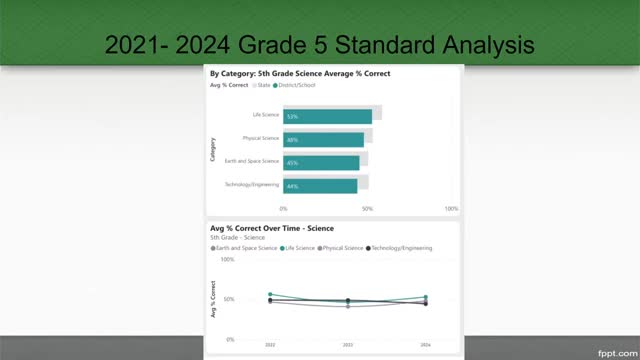Data reveals alarming decline in high school science scores
December 02, 2024 | Dennis-Yarmouth Regional School District, School Boards, Massachusetts
This article was created by AI summarizing key points discussed. AI makes mistakes, so for full details and context, please refer to the video of the full meeting. Please report any errors so we can fix them. Report an error »

In a recent government meeting, educational officials presented a concerning analysis of student performance in science across various grade levels, revealing persistent challenges in achieving state average accuracy rates. The data, spanning from 2022 to 2024, indicates that 5th and 8th graders consistently scored around 50% in science tasks, with a notable negative variance of 4% compared to state averages.
The analysis highlighted a troubling trend among high school students, particularly those in 9th and 10th grades. Ninth graders demonstrated accuracy rates between 40% and 50%, while 10th graders' performance dropped significantly, with accuracy ranging from 20% to 40%. The variance from state averages for 10th graders widened to over 20% in some domains, raising alarms about the effectiveness of the current science curriculum.
Officials noted that students taking the MCAS test in 9th grade generally achieved higher proficiency ratings than those tested in 10th grade, suggesting a need for a reevaluation of the high school science program. To address these issues, plans were outlined to collaborate with educational leaders to refine the curriculum, establish clear learning objectives, and enhance teaching materials.
The meeting concluded with an invitation for questions and comments, signaling a commitment to engage stakeholders in the ongoing effort to improve science education outcomes.
The analysis highlighted a troubling trend among high school students, particularly those in 9th and 10th grades. Ninth graders demonstrated accuracy rates between 40% and 50%, while 10th graders' performance dropped significantly, with accuracy ranging from 20% to 40%. The variance from state averages for 10th graders widened to over 20% in some domains, raising alarms about the effectiveness of the current science curriculum.
Officials noted that students taking the MCAS test in 9th grade generally achieved higher proficiency ratings than those tested in 10th grade, suggesting a need for a reevaluation of the high school science program. To address these issues, plans were outlined to collaborate with educational leaders to refine the curriculum, establish clear learning objectives, and enhance teaching materials.
The meeting concluded with an invitation for questions and comments, signaling a commitment to engage stakeholders in the ongoing effort to improve science education outcomes.
View full meeting
This article is based on a recent meeting—watch the full video and explore the complete transcript for deeper insights into the discussion.
View full meeting
